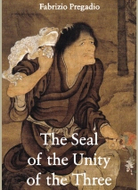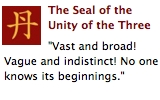Introduction to
The Seal of the Unity of the Three (Cantong qi)
Based on the Introduction of:
Fabrizio Pregadio
Golden Elixir Press, 2011
Paperback ● Hardcover ● PDF (abridged)
Under an allusive poetical language and thick layers of images and symbols, the Cantong qi hides the exposition of the teaching that gave origin to Taoist Internal Alchemy (Neidan). In addition to a complete translation, this book contains a detailed introduction to the history and teachings of the Cantong qi, explanations of each of its sections, and notes on its verses.
 This page is part of a series on the Seal of the Unity of the Three. See the complete index.
This page is part of a series on the Seal of the Unity of the Three. See the complete index.
3. Composition
In most redactions, the Cantong qi is divided into 3 parts. Parts 1 and 2 contain the main text. With the exception of a few short passages in prose, they are written in 4- or 5-character verses (the 5-character verses prevail in the first part, while the second part is almost entirely made of 4-character verses). Several poems written in either meter mirror one another in subject matter and vocabulary.
Part 3 is made of several additional compositions: (1) An "Epilogue" ("Luanci"), mostly written according to the saoti prosody, so called after the Lisao (Encountering Sorrow) piece in the Songs of Chu (Chuci). (2) The "Song of the Tripod" ("Dingqi ge"), a poem in three-character verses, another prosodic form not found in the first two parts. (3) A final section — entitled in different ways by different commentators — stating that the teachings of the Cantong qi are based on the Book of Changes, Taoism, and alchemy, and containing a final poem in which the author describes himself and his work.
In some redactions, moreover, the third part is concluded by an anonymous postface entitled "Eulogium" ("Zanxu").
The "Ancient Text"
In the early 16th century, a new version of the Cantong qi, anachronistically called Guwen cantong qi, or Ancient Text of the Cantong qi, was created on the basis of a complete rearrangement of the scripture. This version divides the sections in verses of 4 characters from those in verses of 5 characters, following a suggestion that was first given by Yu Yan in his commentary of 1284. Yu Yan refers to this as a sudden realization that he had after he finished to write his work:
Index of this article
1. Authorship
2. Date
3. Composition
4. Cosmology
5. Taoism
6. Alchemy
7. Commentaries
Related pages
Suddenly one evening, while I was in complete quietude, I heard something like a whisper saying: "Wei Boyang wrote the Cantong qi, and Xu Congshi composed a commentary. The sequence of the bamboo slips was disrupted; this is why the portions in four-character verses, those in five-character verses, and those in prose are in disorder." . . . I wish I could subdivide the text into three parts, respectively made of four-character verses, five-character verses, and prose, so that text and commentary are not confused, in order to facilitate the inquiries of future students. However, my book is complete, and I cannot change it.
Yu Yan's suggestion was not not unheeded. The origins of the Ancient Text can be traced back to Du Yicheng, who like Yu Yan came from Suzhou and wrote a now-lost commentary on it in 1517. About three decades later, the famous literatus, Yang Shen (1488-1559), claimed to have found the work in a stone casket, and published it under his own name. Since then, the Ancient Text has been mainly associated with Yang Shen.
Several authors of commentaries to the standard version of the Cantong qi have regarded the Ancient Text as spurious, and similar criticism has also been voiced by Chinese scholars from the Qing period onward. This view has been partly influenced by the controversial personality of Yang Shen, who was known to have falsified early Chinese works. Whether the verdict of "non-authenticity" is or is not accurate, it should be considered that the Ancient Text, despite the different arrangement, includes the whole Cantong qi, without any addition and with the omission of only a few verses; and that no one without a solid knowledge of the standard version of the Cantong qi, and of its doctrinal principles, could have fabricated a work of this nature. In the arrangement of the Ancient Text, the 4- and 5-character verses are not reproduced in the same sequence as in the standard version; and in the new arrangement, the discourse of Cantong qi reveals a much clearer pattern.
The Ancient Text gives prominence not only to the three main subjects of the Cantong qi, but also to the three authors earlier deemed to be involved in its composition. This is likely to be the main reason why several commentators, for whom Wei Boyang could only be the single author of the whole Cantong qi, and Internal Alchemy its single subject, rejected the Ancient Text altogether. According to the new version, Wei Boyang wrote the portion entitled "Canon" ("Jing") in verses of 4 characters; Xu Congshi — whom the Ancient Text exegetes regularly identify as Xu Jingxiu, as also did Yu Yan — contributed a "Commentary" ("Zhu") in verses of 5 characters; and Chunyu Shutong added a final section, entitled "The Three Categories" ("San xianglei"). In the Ancient Text, both the "Canon" and the "Commentary" are divided into three chapters, respectively devoted to cosmology, Taoism, and alchemy.
◀ Back: 2. Date
Next: 4. Cosmology ▶










